Compartment syndrome
Compartments in the foot
There are nine foot compartments:
1. medial
2. superficial
3. lateral
4. adductor
5-8. four interossei
9. calcaneal
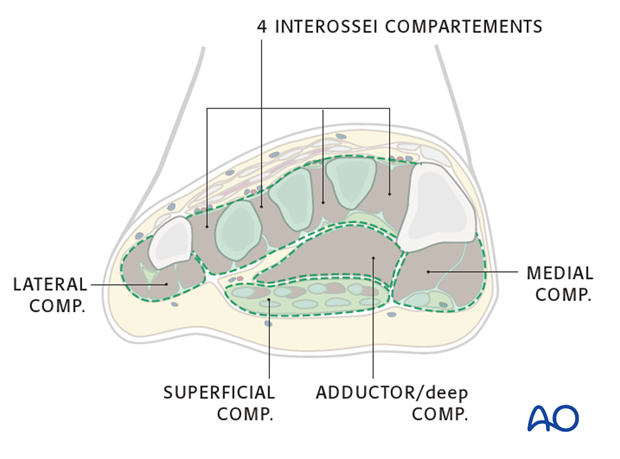
The medial contains the abductor hallucis and flexor hallucis brevis muscles, and is plantar-medial to the first metatarsal.
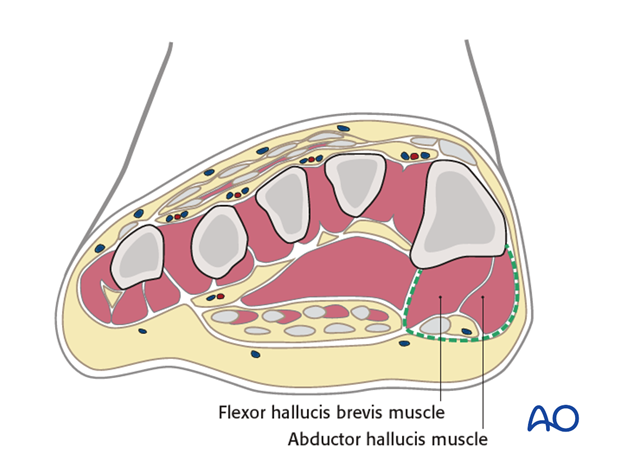
The superficial contains the flexor digitorum longus and brevis muscles.
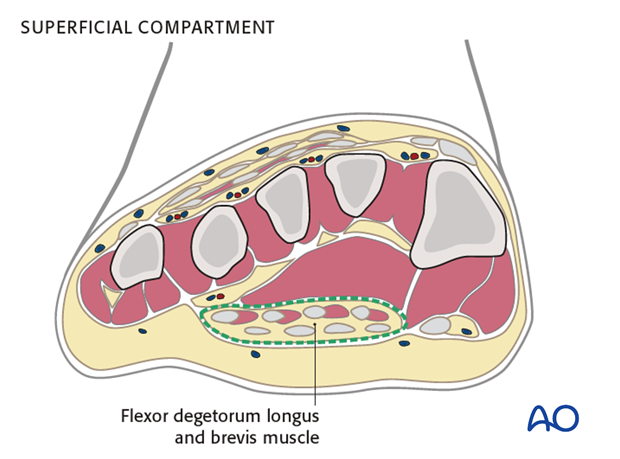
The lateral contains the abductor digiti minimi and flexor digiti minimi brevis, and is on the inferiolateral surface of the fifth metatarsal.

The adductor or deep compartment is located in the plantar forefoot, containing the oblique head of the adductor hallucis muscle.
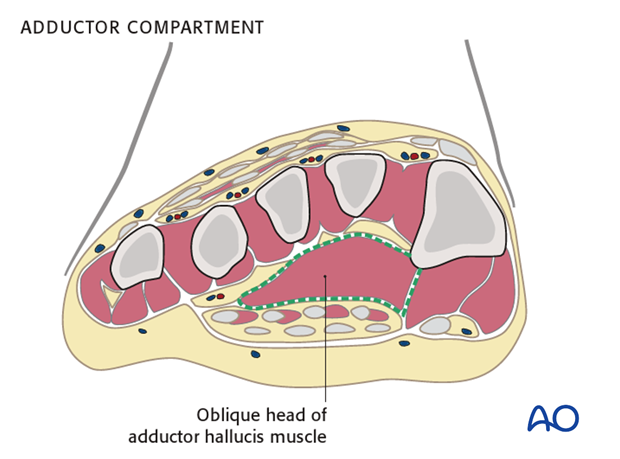
The four interossei compartments are dorsally located between each of the metatarsals, and each includes dorsal and plantar interosseus muscles.
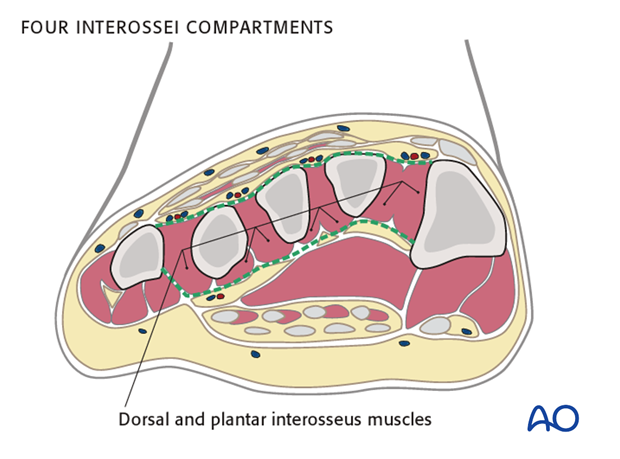
The calcaneal compartment contains the quadratus plantae muscle.
Note: A communication was demonstrated between the calcaneal compartment and the deep posterior compartment of the leg through the retinaculum behind the medial malleolus, following the neurovascular and tendinous structures.
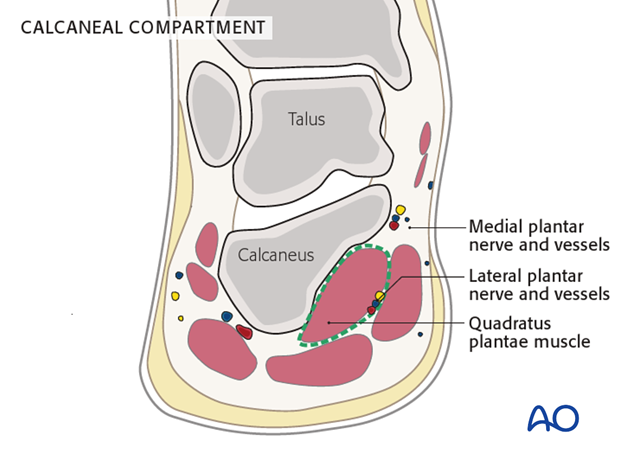
In calcaneal fractures, the sustentacular calcaneal fragment causes bleeding from the bone or the medial calcaneal arteries into this compartment. The medial and lateral plantar nerves and vessels are then compressed between the quadratus plantae muscle and the short flexor digitorum muscle (flexor digitorum brevis).
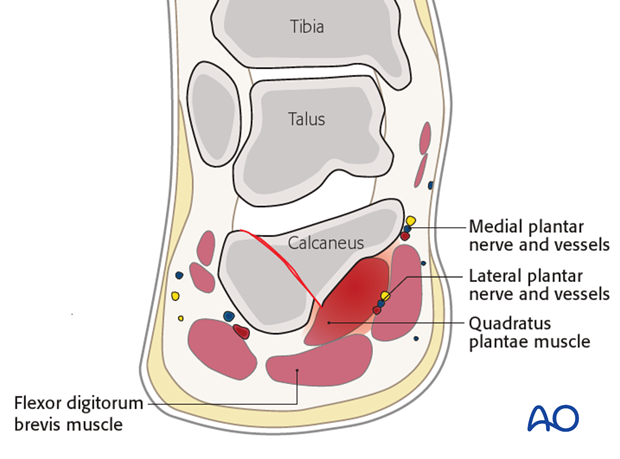
General considerations
In summary, compartment syndrome of the foot and leg can lead to devastating complications. Early suspicion and treatment may prevent this from happening. Compartment syndrome is a clinical diagnosis and treatment should not be delayed if a measuring tool is not immediately available. Open incision release may save an extremity with the only downside of being the need for future cosmetic scar revision.
If compartment syndrome of the foot is missed, or left untreated, long term surgery may be needed in the form of reconstruction or release of intrinsic toe contractures. Mild compartment syndrome of the foot may leave very minor sequelae only. A debate exists in the literature and among trauma and foot experts as to the efficacy of compartment releases.
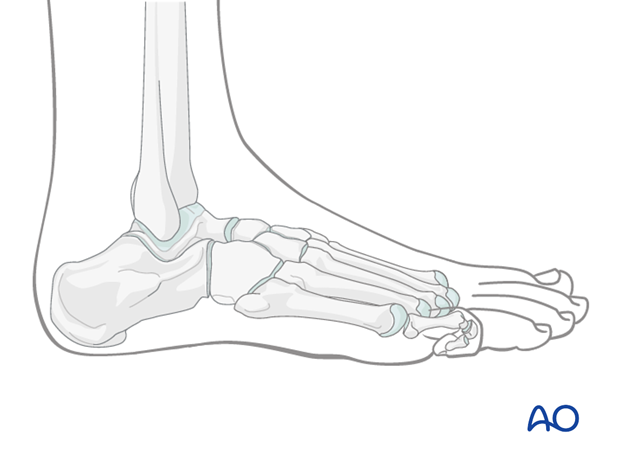
After the fasciotomy is performed, any metatarsal fractures can be fixed with small plates and screws. Occasionally, Kirschner wires are useful. Lisfranc joint injuries can be fixed with screws using standard techniques.
The problem is that these wounds cannot be closed and must be left open, often with metal in their depth, with considerable risk of infection.
Specifics of diagnosing CS in the foot
Potential complication of high-energy injuries (MVA, fall from height), foot crush injury, fractures (multiple metatarsals, Lisfranc injury, calcaneal), surgery, and vascular injury.
Diagnosis of compartment syndrome in the foot is primarily a clinical diagnosis with a need for high suspicion.
In the setting of these foot injuries, the usual signs of increased local pain, decreased sensation, or passive stretch pain in the foot are often unreliable.
Tense swelling and severe pain are the hallmarks of an impending compartment syndrome; the most consistent physical finding being tense swelling of the foot. The treatment is decompression without delay.
There is no clinical tool that allows a surgeon to know whether or not the foot that has compartment syndrome can be salvaged safely with surgical release.
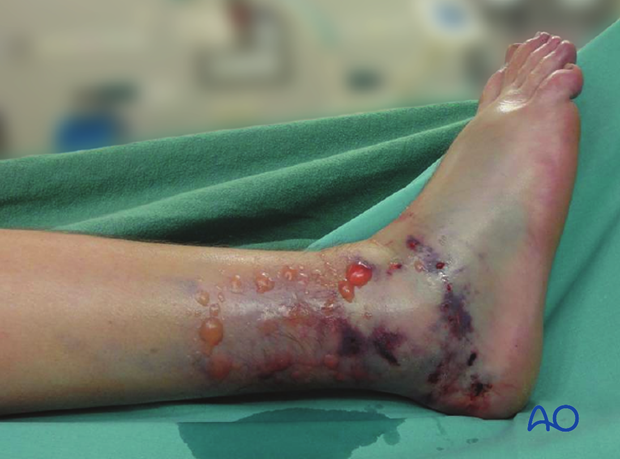
Compartment pressure monitoring is a useful confirmatory test. There are compartment pressure measuring devices which are commercially readily available. Where one is not available, one can easily make a measuring device using a transducer which one can borrow from anaesthesia, where they are in use to measure arterial pressures. If this is not available, a mercury column blood pressure measuring device will do as described by Whitesides.
The presence of 9 compartments necessitates multi-stick needle catheterization for direct measurement of compartment pressures. The compartments involved are usually adjacent to the areas of injury, but may be more remote. A patient with a calcaneal fracture might have hindfoot compartment syndrome, but may have any or all of the compartments involved.
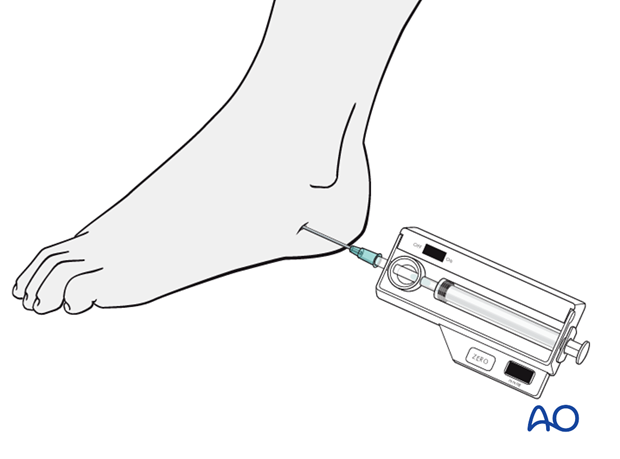
The threshold for considering compartment syndrome and performing fasciotomy must/should be low to minimize the poorly-tolerated outcomes.
Acute dermato-fasciotomy of any of the nine compartments is indicated when compartment pressure exceeds 30 mmHg, or if compartment pressure is greater than 10- 30 mmHg less than the diastolic pressure.
Normal pressures in the foot have been shown to be 5 +/- 3 mmHg, with a range of 1 to 12 mmHg (‘Foot & Ankle Trauma’, 2nd Edition).
It is important to attempt to reach the calcaneal compartment when involved (in the case of hind-foot trauma), as it appears to be the most sensitive.
Treatment principles
The approaches for compartment decompression generally include two dorsal incisions for access to forefoot/interossei compartments, and one medial incision for decompression of the calcaneal, medial, superficial and lateral compartments.
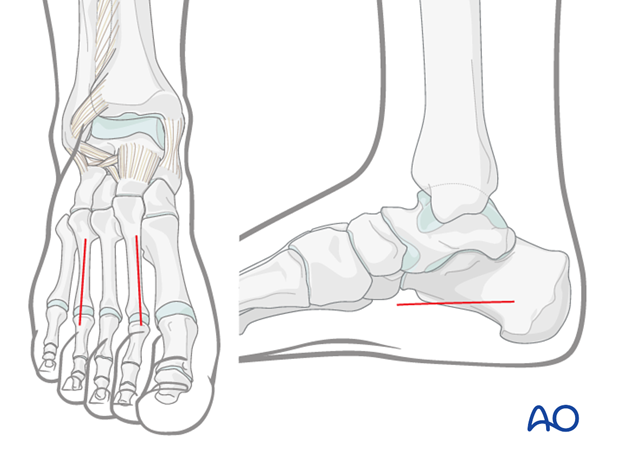
An alternative incision, which is useful especially in severe trauma for foot and leg salvage, starts at the base of the second toe and progresses to the mid-ankle region. It then ascends the leg over the anterior compartment. In cases of severe leg trauma or crush injury a more thorough decompression is possible all the way up to the knee. In order to reach the superficial and deep compartments one must undermine the soft tissue flap on the medial side.
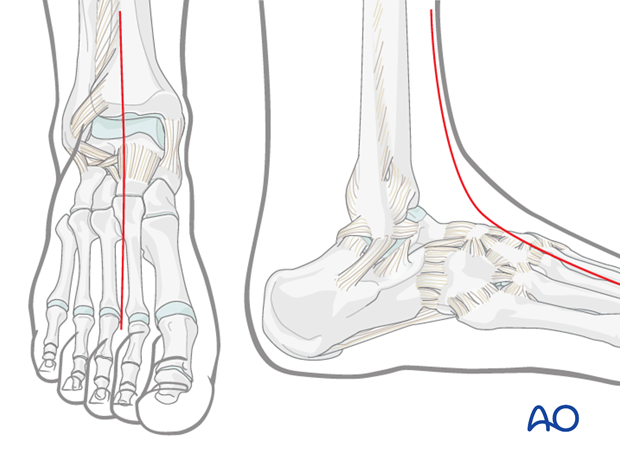
Double-dorsal incision
The two dorsal incisions are placed one medial to the second metatarsal shaft and one lateral to the fourth metatarsal shaft.
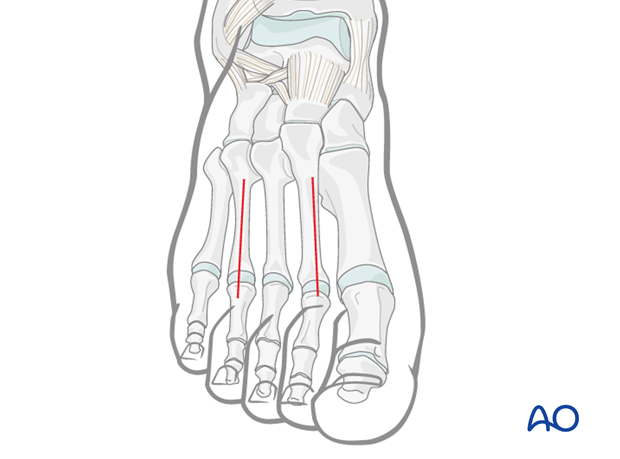
The fascias of the interosseous muscles are opened dorsally. The muscle is stripped off the second metatarsal medially and the fascia of the adductor compartment is opened bluntly deep within the first interspace.
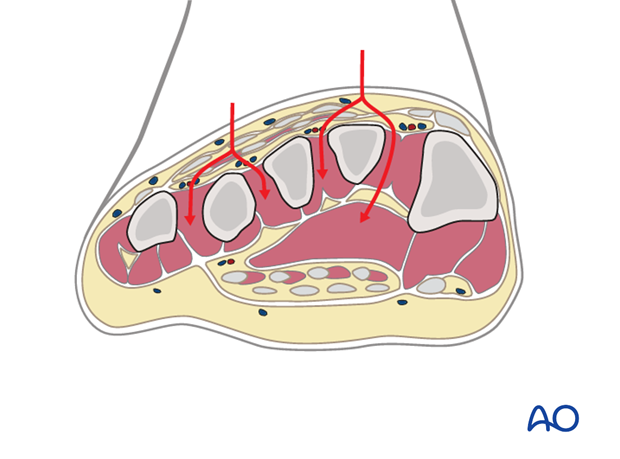
Medial incision
The medial incision is made within the arch of the foot, along the muscle body of the abductor hallucis.
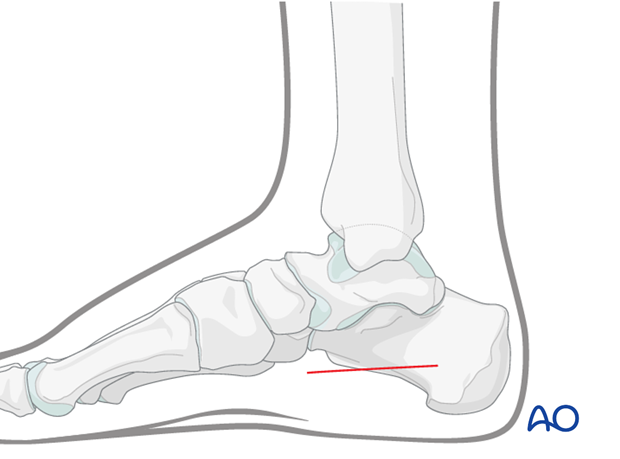
Dissection is continued both dorsal and plantar to the abductor hallucis muscle, which also serves to disrupt the superficial and deep components of the central compartment and allows access to the adductor muscle belly. (Rockwood & Green)
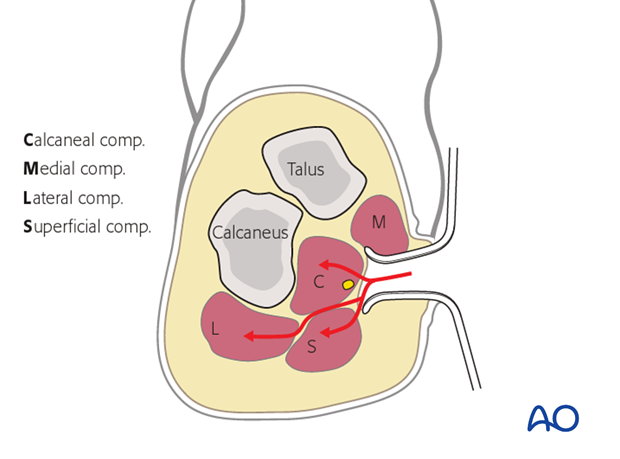
Prognosis
Long-term sequelae of foot compartment syndrome (FCS) may include contractures deformity, weakness, paralysis, and sensory neuropathy. Mild compartment syndrome of the foot may leave very minor sequelae only. A debate exists in the literature and among trauma and foot experts as to the efficacy of compartment releases.
Claw toe deformity following calcaneus fracture appears to be due to late contracture of the quadratus plantae muscle in the calcaneal compartment
CS of the calcaneal compartment, since it can communicate with the deep posterior compartment of the leg, can lead to severe and functionally devastating deformity of the foot and ankle. If the posterior tibialis musculotendinous unit necroses or dies, it can lead to severe equina-cavovarus deformity.
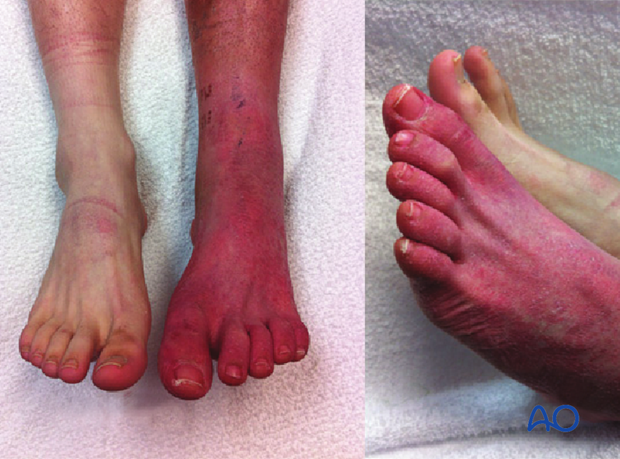
Aftercare
Fasciotomy wounds may require delayed primary closure (left), negative pressure device (NPWD), pie crusting (right) or skin grafting.
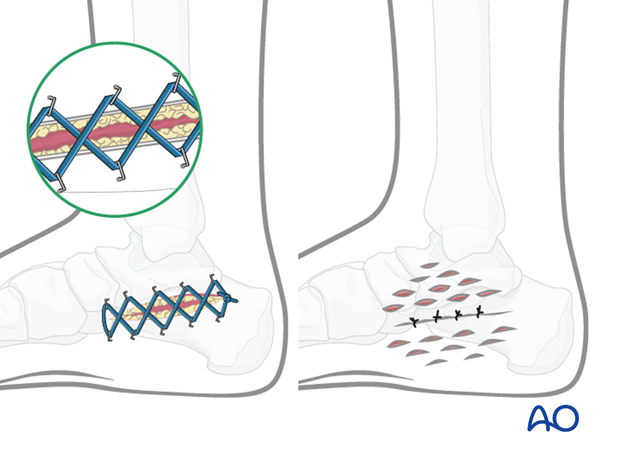
Late reconstruction in the presence of subsequent deformity
- Excision of scarred muscle, tenotomies and correction of structural deformities with tendon transfers and rebalancing
- Provide a plantigrade foot without static structural deformity, providing the patient the possibility of wearing standard shoe ware (AAOS- OKU Foot & Ankle)
Once the wounds are appropriately dressed, provide posterior splinting to prevent equinus deformity from developing.
Elevating the foot while seated will not reduce swelling.
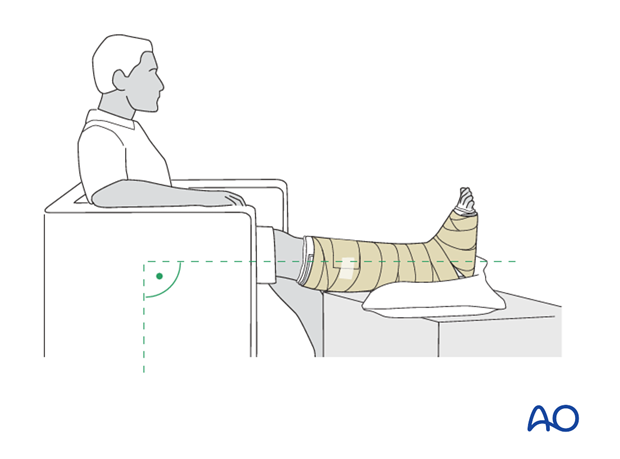
If the foot is badly swollen the patient must be supine and the extremity must be elevated so that the foot is higher than the heart.













